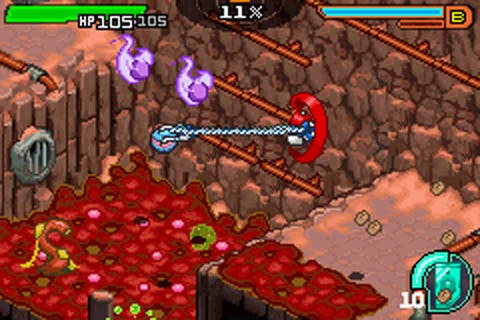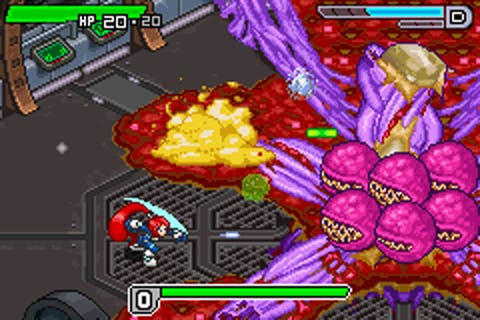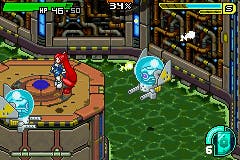Scurge: Hive
Screen digest.
Remember when the DS was first announced? And none of us could figure out what good, exactly, a second screen on a handheld console was supposed to do? 'I hope it's not just used as a map screen all the time,' went our derisory cry, accompanied by much tutting and shaking of heads, because, well, we couldn't think of anything better ourselves. It seemed so obvious, so pointless.
Two years down the line and, inevitably, many more imaginative uses for the twin screens have surfaced; and, just as inevitably, dozens upon dozens of games have reached our hands, especially those with no use for touchscreen control, apologetically bearing nothing more than a map on the secondary display. But our moans and claims of creative bankruptcy have been notable by their absence. Why? Because map screens are great. Think how much more painless retreading Resident Evil's corridors was with a map you could glance at any time without pausing play. Think how the tight overhead view, with item-tracking, revolutionised multiplayer Mario Kart.

A map screen is basically all that the DS version of Scurge: Hive offers over its GBA counterpart. Well, that's fine by us. Especially since this tidy little action game is basically an isometric reworking of Metroid, and thus involves plenty of backtracking and criss-crossing through the labyrinthine, gloop-smeared gangways of some disused space factory or other, in pursuit of the next power-up which will unlock that mysterious door that you saw- where was it again?
Pause-free pathfinding aside, don't expect anything from Scurge on DS that handheld games haven't being doing since last century, and that home console games didn't used to do back before that. It's an unapologetically 16-bit throwback, a pixellated, Manga-influenced, button-bashing, enemy-respawning, alarm-sounding, raspy-synthesized-heavy-metal-soundtracked ghost of 1993s past. It sounds terrible and looks good, and is pretty much totally derivative, but in this day and age a game like Scurge: Hive can be a welcome reminder of what games were like before they became a self-aware entertainment phenomenon, especially if it's good. And Scurge: Hive is, quite.

The debt to Metroid is obvious and complete the moment you're presented with the title screen's eerie synth chords and organic blob in a containment vessel. But in case you were in any doubt, you play a female space bounty hunter (Jenosa Arma) sent to investigate a distress signal from a research lab that was investigating a mysterious and powerful organism - the Scurge of the title - that can control organic, mechanical and energy beings. She is naturally clothed in a special suit of armour, although this one lets her absurdly huge ribbon of red hair run free - a distinguishing and cute touch of super-deformed style.
Neither will it come as any surprise that her arm-cannon can be upgraded with new elemental powers, although the way these are applied basic enemy types - electric pulses shorting out robots double-quick but charging up energy beings, discharge shots dissipating energy beings but making organic beasties stronger - adds a twist of RPG to the mostly frantic shooting, puzzling and exploration. That's echoed in the way you can level Jenosa up by defeating enemies, a necessary counterbalance in a game where you can so frequently jump and run your way out of any confrontation.

Scurge's other departure from Samus' footsteps is the ever-present nature of the Scurge infection. Jenosa suffers from it, and though the suit slows it down, it's a matter of minutes before the infection meter reaches 100 per cent and it starts to kill her very quickly. So you'll need to constantly decontaminate (and simultaneously, save) at the fairly common sick-bay points, which essentially breaks this otherwise meandering game up into a series of five-minute timed challenges as you attempt to unlock a door, solve a puzzle or beat a boss before you need to recharge. It sounds frustrating, but actually it keeps the pace of the game brisk and tension levels high, and forces a bite-sized approach to level design that suits a handheld game well, and artfully disguises the lack of any deep inspiration or long-term challenge in the game.
The action itself is more of a disappointment: like so many isometric games, Scurge suffers from the fact that you're often required to aim your gun, or perform tricky jumps, along diagonals, which are much fiddlier to find and more uncomfortable to hold. It's that simple fact above all else that prevents it from offering the razor-sharp combat or platforming that are needed to really distinguish such an old-school action game. It's rather relentless too, every room packed with swarming, belching, bleeping enemies that harass you, knock you into each other, off a ledge or out of the door - arguably the worst fate, because on re-entry, you'll find that they've all respawned. A little more dynamic pacing, more moments of quiet and rest might have helped Scurge edge closer to the powerful atmosphere of its inspiration.
But Scurge is still hugely attractive - packed with charismatic enemy design and pin-sharp pixel-art, it's a real looker, in its old-fashioned way - moderately addictive, mildly nostalgic, and pleasantly to the point. It's probably more compelling as a reason to dig out your Micro than pull a dedicated DS game out of your Lite. But that would depend on how much you like map screens...








